Seven space-efficient plants will transform your indoor air quality while fitting perfectly in tight spaces. The Snake Plant, Spider Plant, ZZ Plant, Peace Lily, Pothos, Chinese Evergreen, and Air Plant all feature minimal root systems and powerful air-purifying abilities. You'll find these low-maintenance options remove toxins like formaldehyde and benzene while thriving in various light conditions. Discover how each unique plant can maximize your space's potential and health benefits.
Snake Plant: A Compact Air-Cleaning Champion
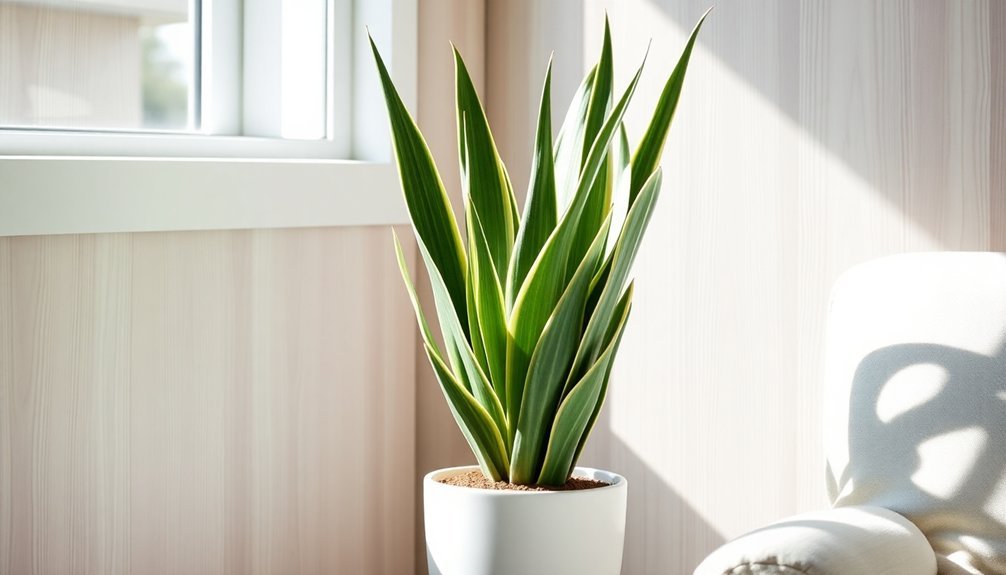
One of nature's most efficient air purifiers, the Snake Plant combines space-saving design with powerful air-cleaning abilities.
You'll appreciate how this resilient plant thrives in small spaces with limited natural light, making it perfect for any room in your home.
Don't let its striking visual element fool you – this air-purifying powerhouse works hard to remove indoor toxins like formaldehyde, benzene, and xylene from your environment.
What's even better is that it continues working overnight, producing oxygen while you sleep, which makes it an ideal bedroom companion.
If you're new to plant care or have a busy lifestyle, you'll love that the Snake Plant requires minimal care.
It's forgiving of irregular watering and grows upright, maximizing vertical space while keeping its footprint small.
Spider Plant's Space-Efficient Root Structure
Space-savvy enthusiasts will love the Spider Plant's compact root structure, which makes it a perfect choice for tight spaces and small containers. The small roots require minimal soil depth, helping you avoid overwatering while maintaining a low-maintenance care routine.
You'll appreciate how this space-efficient plant adapts to various light conditions, thriving in indirect light and even lower-light environments.
As one of nature's most effective air-purifying plants, it filters harmful pollutants like formaldehyde and carbon monoxide from your home's atmosphere.
The Spider Plant's compact root system doesn't just save space – it also supports the plant's ability to produce offspring. These baby plants can be easily propagated, allowing you to expand your collection of air-purifying greenery without sacrificing precious space on your shelves or windowsills.
ZZ Plant's Minimal Root Footprint
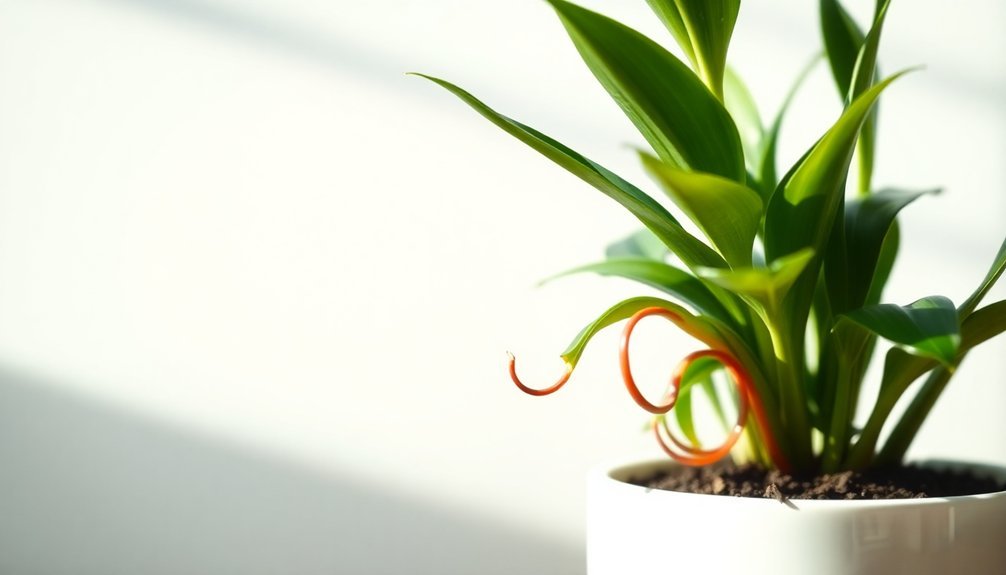
You'll appreciate how the ZZ Plant's compact root system fits perfectly into small containers without demanding deep soil or extensive space.
The plant's efficient growth pattern allows you to place it in tight spots where other houseplants wouldn't thrive, making it ideal for apartments and small rooms.
Its well-organized root structure stores water effectively while maintaining a minimal footprint, so you won't need to sacrifice precious space for this air-purifying powerhouse.
Compact Growth Pattern
When it comes to efficient indoor plant choices, the ZZ plant stands out for its remarkably compact growth pattern and minimal root footprint.
You'll appreciate how this space-saving plant adapts perfectly to tight corners and small spaces in your indoor environments, thanks to its well-organized structure and shallow roots.
The ZZ plant's efficient design doesn't compromise its air-purifying capabilities. Its underground tubers excel at water storage, while the small roots system maintains stability without requiring deep pots.
You'll find it's incredibly low-maintenance, as it thrives in various light conditions without needing extensive root systems for moisture absorption.
Whether you're dealing with limited space or you're new to plant care, the ZZ plant's compact growth pattern makes it an ideal choice for modern living spaces.
Root System Basics
The ZZ plant's minimal root footprint sets it apart as a remarkable indoor plant choice. Its shallow root system lets you maximize limited spaces while enjoying powerful air-purifying capabilities. You'll appreciate how this resilient plant can adapt to various pot sizes without compromising its health.
| Feature | Benefit | Impact |
|---|---|---|
| Shallow roots | Fits small containers | Space-saving |
| Water storage | Drought-tolerant | Low-maintenance |
| Nutrient efficiency | Less soil needed | Cost-effective |
The ZZ Plant's root system effectively stores water and nutrients, making it incredibly low-maintenance. You won't need to worry about frequent watering or repotting, as it thrives in compact containers. This adaptability makes it perfect for busy plant parents who want to enjoy the benefits of an air-purifying plant without dedicating excessive space or time to maintenance.
Peace Lily's Shallow Root System
The Peace Lily's shallow root system makes it an excellent choice for apartment dwellers seeking compact air-purifying plants that won't outgrow their space.
You'll find its roots extend just a few inches deep, allowing you to place this versatile plant in small containers on shelves or tables while it effectively removes indoor toxins.
Your Peace Lily's minimal root footprint means you can easily monitor soil moisture and prevent overwatering, ensuring healthy growth in tight spaces.
Peace Lily Root Care
Managing Peace Lily's shallow root system requires a delicate balance of care, as these air-purifying plants only extend their roots a few inches deep.
You'll need to be mindful of their unique needs when growing them in small pots and compact spaces.
To prevent root rot, it's essential to avoid overwatering your Peace Lily.
Check the top inch of soil for dryness before watering to maintain ideal moisture levels.
Using well-draining soil will help protect the shallow root system by improving aeration and preventing waterlogged conditions.
When it's time for repotting, handle your Peace Lily with extra care since its shallow roots are easily damaged.
Choose a pot that's just slightly larger than the current one to support healthy growth without overwhelming the delicate root system.
Compact Growth Benefits
Building on the Peace Lily's unique root structure, its compact growth pattern offers significant advantages for space-conscious plant enthusiasts.
You'll find that Peace Lilies thrive in small pots thanks to their shallow root system, making them perfect for tight spaces in your home.
These versatile plants are particularly low-maintenance due to their efficient absorption of water and nutrients through their compact root structure.
You won't need to water them as frequently since they require less soil volume.
Their space-saving design allows you to place them on desks, shelves, or bedside tables while still enjoying their air-purifying benefits.
Even in minimal space, your Peace Lily will effectively filter out pollutants like ammonia and formaldehyde, enhancing your indoor air quality without compromising valuable living space.
Pothos: The Small-Rooted Air Purifier
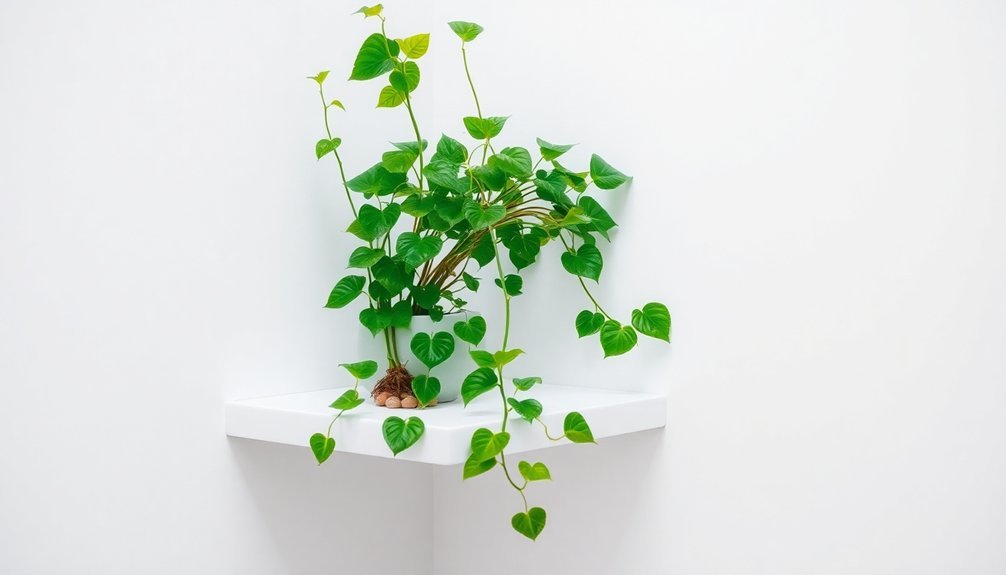
Among versatile air-purifying plants, Pothos stands out as a space-efficient champion that packs powerful air-cleaning abilities into a compact root system. You'll love how this low-maintenance plant removes toxins like formaldehyde and benzene while adapting to various lighting conditions. Its small root system makes it perfect for tight spaces, and its trailing vines create stunning visual interest in hanging planters.
| Feature | Benefit |
|---|---|
| Small Roots | Fits in limited spaces |
| Air Purification | Removes harmful toxins |
| Adaptability | Thrives in low light |
| Pet-Friendly | Safe for households with animals |
| Easy Care | Tolerates neglect well |
This resilient plant won't demand much of your attention while it improves your indoor air quality, making it an ideal choice for busy plant owners who want maximum benefits with minimal effort.
Chinese Evergreen's Root-Friendly Design
While many indoor plants demand ample root space, the Chinese Evergreen proves that effective air purification doesn't require extensive root systems. Its root-friendly design makes it perfect for your indoor environment, especially when you're working with limited space.
You'll appreciate how this plant's compact root system helps it thrive in small pots while effectively absorbing toxins like benzene and formaldehyde.
Here's what makes the Chinese Evergreen's small roots so remarkable:
- They adapt to various soil types without spreading extensively
- Their shallow structure helps prevent root rot in low light conditions
- The compact design maximizes nutrient absorption in minimal space
- Low maintenance roots don't require frequent repotting or special care
This efficient root structure makes the Chinese Evergreen an ideal choice for both beginners and space-conscious plant enthusiasts.
Air Plant's Rootless Purification Power
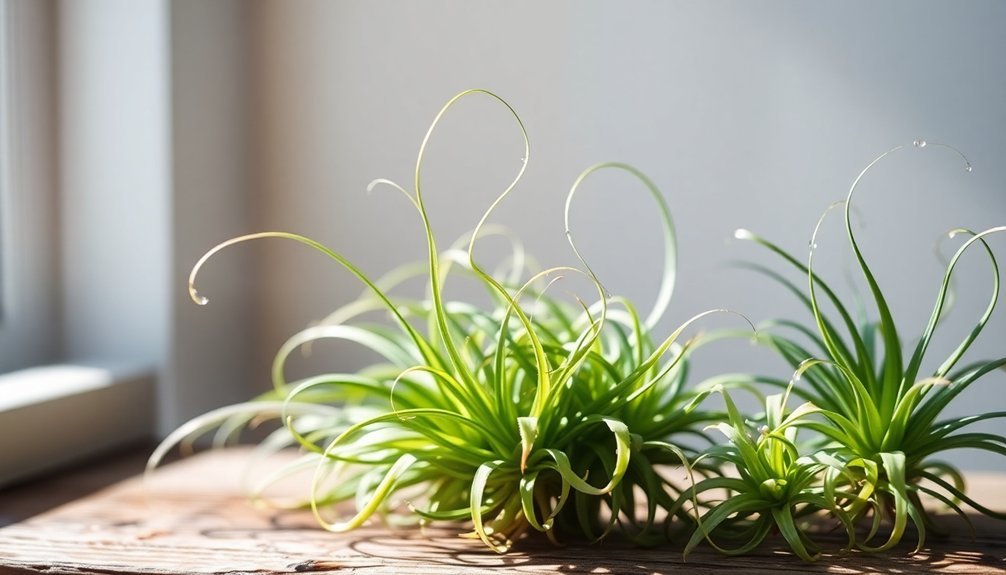
The remarkable Air Plant defies conventional wisdom by purifying your indoor air without any roots at all. These innovative plants use photosynthesis to convert carbon dioxide into oxygen while removing harmful toxins like formaldehyde and benzene from your environment.
| Feature | Benefit |
|---|---|
| Rootless Design | Perfect for tight spaces |
| Air Purification | Removes harmful toxins |
| Low Maintenance | Minimal care required |
| Versatile Display | Suits any decor style |
| Bright Indirect Light | Thrives in most rooms |
You'll love how these small but mighty plants create a healthier living space without demanding much attention. Place them in creative displays, from hanging terrariums to wall-mounted arrangements, and watch them thrive while they clean your air. Their ability to absorb nutrients directly through their leaves makes them an ideal choice for busy individuals seeking efficient air purification solutions.
Frequently Asked Questions
What Plant Removes 78% of Airborne Mold?
You'll want to get a Boston Fern (Nephrolepis exaltata) for your home, as it removes 78% of airborne mold spores. It's one of nature's best air purifiers when properly maintained.
What Plant Purifies the Air the Most?
You'll get the most air purification from the peace lily, as it effectively removes multiple toxins like ammonia, benzene, formaldehyde, and trichloroethylene. It's considered one of the best air-purifying houseplants available.
What Plant Is NASA Recommend for Air Purifiers?
NASA recommends Peace Lilies, Spider Plants, Boston Ferns, and Snake Plants for air purification. You'll get the best results with Peace Lilies, as they're particularly effective at removing multiple toxins from your indoor air.
What Is the Healthiest Plant to Have in Your House?
You'll benefit most from having a Peace Lily in your home. It's the healthiest choice as it removes multiple toxins like ammonia, benzene, and formaldehyde while producing oxygen and adding beautiful white blooms.
In Summary
You'll find these seven space-saving plants perfect for purifying your air without demanding much root space. Whether you choose the sleek snake plant, the cascading spider plant, or the rootless air plant, you're getting powerful air cleaners in compact packages. Place them strategically around your home and enjoy cleaner air while maximizing your living space. These plant options prove you don't need deep pots for effective air purification.

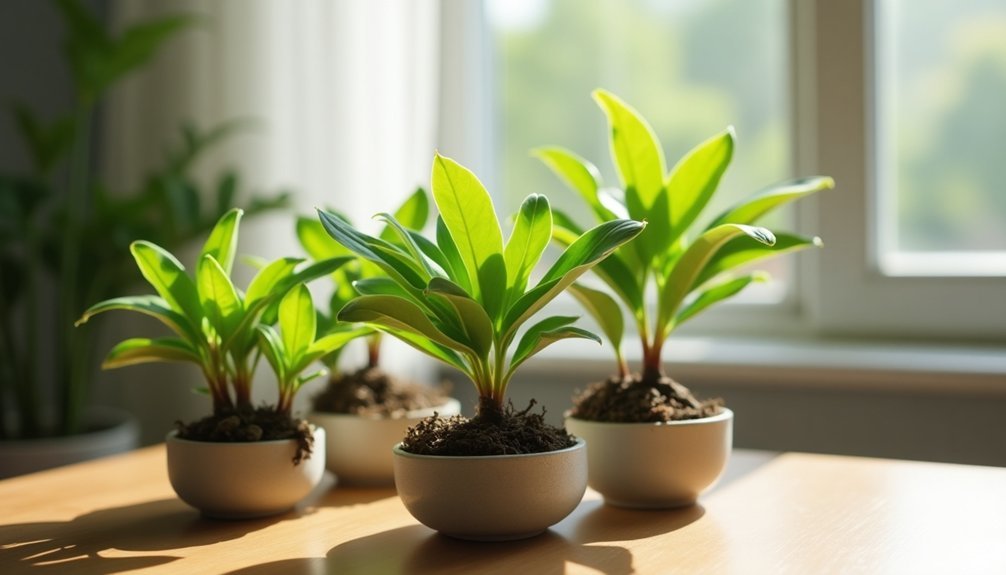



Leave a Reply